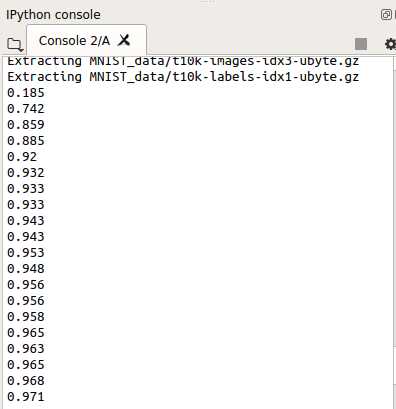标签:print oss ted set between truncated res eal port
CNN实现
#!/usr/bin/env python2 # -*- coding: utf-8 -*- """ Created on Mon Apr 8 02:46:09 2019 @author: xiexj """ import tensorflow as tf from tensorflow.examples.tutorials.mnist import input_data mnist=input_data.read_data_sets(‘MNIST_data‘, one_hot=True) def compute_accuracy(v_xs, v_ys): # global prediction y_pre = sess.run(prediction, feed_dict={xs:v_xs,keep_prob:1}) correct_prediction = tf.equal(tf.argmax(y_pre,1),tf.argmax(v_ys,1)) accuracy = tf.reduce_mean(tf.cast(correct_prediction, tf.float32)) result = sess.run(accuracy, feed_dict={xs:v_xs,ys:v_ys,keep_prob:1}) return result def weight_variable(shape): initial = tf.truncated_normal(shape, stddev=0.1) return tf.Variable(initial) def bias_vatiable(shape): initial = tf.constant(0.1, shape=shape) return tf.Variable(initial) def conv2d(x, W): return tf.nn.conv2d(x, W, strides=[1,1,1,1], padding=‘SAME‘) def max_pooling_2x2(x): return tf.nn.max_pool(x, ksize=[1,2,2,1], strides=[1,2,2,1], padding=‘SAME‘) # define placeholder for inputs to network xs = tf.placeholder(tf.float32, [None, 784]) ys = tf.placeholder(tf.float32, [None, 10]) keep_prob = tf.placeholder(tf.float32) x_image = tf.reshape(xs, [-1, 28, 28, 1])# [n_samples, 28,28,1] ## conv1 layer ## W_conv1 = weight_variable([5,5,1,32]) b_conv1 = bias_vatiable([32]) h_conv1 = tf.nn.relu(conv2d(x_image, W_conv1) + b_conv1) h_pool1 = max_pooling_2x2(h_conv1) ## conv2 layer ## W_conv2 = weight_variable([5,5,32,64]) b_conv2 = bias_vatiable([64]) h_conv2 = tf.nn.relu(conv2d(h_pool1, W_conv2) + b_conv2) h_pool2 = max_pooling_2x2(h_conv2) ## fc1 layer ## W_fc1 = weight_variable([7*7*64, 1024]) b_fc1 = bias_vatiable([1024]) h_pool2_flat = tf.reshape(h_pool2, [-1,7*7*64]) h_fc1 = tf.nn.relu(tf.matmul(h_pool2_flat, W_fc1) + b_fc1) h_fc1_drop = tf.nn.dropout(h_fc1, keep_prob) ## fc2 layer ## W_fc2 = weight_variable([1024, 10]) b_fc2 = bias_vatiable([10]) prediction = tf.nn.softmax(tf.matmul(h_fc1_drop, W_fc2) + b_fc2) # the error between prediction and real data cross_entropy = tf.reduce_mean(-tf.reduce_sum(ys * tf.log(prediction), reduction_indices=[1])) train_step = tf.train.AdamOptimizer(0.0001).minimize(cross_entropy) init = tf.global_variables_initializer() with tf.Session() as sess: sess.run(init) for i in range(1000): batch_xs, batch_ys = mnist.train.next_batch(100) sess.run(train_step, feed_dict={xs:batch_xs,ys:batch_ys,keep_prob:0.5}) if i%50 == 0: print(compute_accuracy(mnist.test.images[:1000], mnist.test.labels[:1000]))

标签:print oss ted set between truncated res eal port
原文地址:https://www.cnblogs.com/exciting/p/10673336.html